Wikipedia:Picture of the day/January 2022
|
Featured picture tools: |
These featured pictures, as scheduled below, appeared as the picture of the day (POTD) on the English Wikipedia's Main Page in January 2022. Individual sections for each day on this page can be linked to with the day number as the anchor name (e.g. [[Wikipedia:Picture of the day/January 2022#1]] for January 1).
You can add an automatically updating POTD template to your user page using {{Pic of the day}} (version with blurb) or {{POTD}} (version without blurb). For instructions on how to make custom POTD layouts, see Wikipedia:Picture of the day.Purge server cache
January 1

|
The euro sign (€) is the currency symbol used for the euro, the official currency of the eurozone and a few other European countries. The design was presented to the public by the European Commission on 12 December 1996, and consists of a stylized letter E (or epsilon) crossed by two lines instead of one. While the Commission intended the euro sign to be a prescribed glyph, type designers made it clear that they intended instead to adapt the design to be consistent with the typefaces to which the symbol was to be added. Euro banknotes and coins entered into circulation on 1 January 2002, making it the day-to-day operating currency of its original members. This diagram shows the construction of the euro sign as formally specified by the European Commission. Diagram credit: Erina
Recently featured:
|
January 2
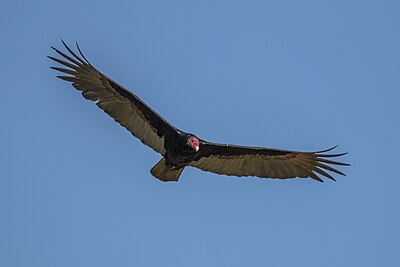
|
The turkey vulture (Cathartes aura) is the most widespread of the New World vultures, with a range extending from southern Canada to the southernmost tip of South America. It feeds primarily on a wide variety of carrion, from small mammals to large herbivores, preferring those recently dead to putrefying carcasses; it rarely kills prey itself. Populations appear to be stable, and it is listed as a least-concern species by the International Union for Conservation of Nature. This photograph shows a turkey vulture in flight in Cuba. It employs static soaring flight, in which it flaps its wings infrequently, and takes advantage of rising thermals to stay aloft. Photograph credit: Charles James Sharp
Recently featured:
|
January 3

|
|
In optical mineralogy and petrography, a thin section is a thin slice of a rock, mineral, soil, pottery, bones, or even metal sample, prepared in a laboratory, for use with a polarizing petrographic microscope, electron microscope and electron microprobe. A thin sliver of rock is cut from the sample with a diamond saw and ground optically flat. It is then mounted on a glass slide and then ground smooth using progressively finer abrasive grit until the sample is only 30 micrometres (0.0012 in) thick. This image shows a thin section of Siilinjärvi apatite ore from Finland in cross-polarized transmitted light; the specimen depicted here is approximately 36.6 mm (1.44 in) wide by 20 mm (0.79 in) high. Photograph credit: Kallerna
Recently featured:
|
January 4

|
Geastrum triplex is a species of inedible fungus found growing in the detritus and leaf litter of hardwood forests around the world. It is the largest member of the genus Geastrum, the earthstar fungi, and expanded mature specimens can reach a tip-to-tip length of up to 12 centimetres (4.7 in). This G. triplex fruiting body was photographed in the Royal National Park in New South Wales, Australia. Photograph credit: John Harrison
Recently featured:
|
January 5

|
Umberto Eco (5 January 1932 – 19 February 2016) was an Italian medievalist, philosopher, semiotician, cultural critic, political and social commentator, and novelist. In English, he is best known for his popular 1980 novel The Name of the Rose, a historical mystery combining semiotics in fiction with biblical analysis, medieval studies, and literary theory, and Foucault's Pendulum, his 1988 novel that touches on similar themes. This photograph of Eco was taken in 1984, during the period of more than thirty years in which he taught at the University of Bologna. Photograph credit: Rob Bogaerts
Recently featured:
|
January 6
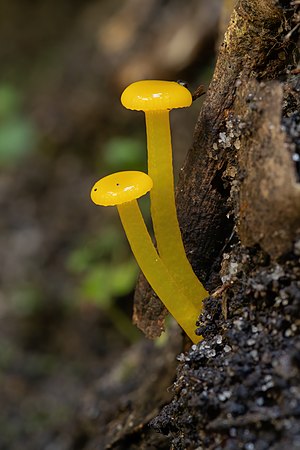
|
Gliophorus chromolimoneus is a species of agaric fungus in the family Hygrophoraceae found in New Zealand and Australia. The yellow fruiting bodies are sticky to the touch, and appear among the leaf litter under Nothofagus, Kunzea ericoides and Leptospermum scoparium trees. These two G. chromolimoneus fruiting bodies were photographed in Ferndale Park in New South Wales, Australia. Photograph credit: John Harrison
Recently featured:
|
January 7

|
This historical coat of arms of Illinois is an illustration from State Arms of the Union by Henry Mitchell, published by Louis Prang in 1876. It depicts a bald eagle perched on a rock carrying a shield with the stars and stripes. In the eagle's beak there is a banner with the state motto, "State Sovereignty, National Union." Illustration credit: Henry Mitchell; restored by Andrew Shiva
Recently featured:
|
January 8

|
The polychrome wooden vault and bimah of the Gwoździec Synagogue, painstakingly reconstructed in 2014, is the centerpiece of the permanent exhibition at the Polin Museum of the History of Polish Jews in Warsaw, Poland. The original synagogue, built in c. 1640 in what is now the Ukrainian town of Hvizdets, was burnt down in 1941 by Nazi German forces. Photograph credit: Magdalena Starowieyska, Dariusz Golik
Recently featured:
|
January 9

|
Carrie Chapman Catt (January 9, 1859 – March 9, 1947) was an American women's suffrage leader who campaigned for the Nineteenth Amendment to the United States Constitution, which gave U.S. women the right to vote. One of the best-known women of her time, Catt served as President of the National American Woman Suffrage Association from 1900 to 1904 and again from 1915 to 1920. She founded the International Woman Suffrage Alliance, later named the International Alliance of Women in 1904, and the League of Women Voters in 1920. Photograph credit: unknown; restored by Adam Cuerden |
January 10

|
The southern rough-winged swallow (Stelgidopteryx ruficollis) is a small member of the swallow family, Hirundinidae. It is native to Central and South America, with some populations being sedentary and others migratory. It occurs in forest clearings and other open areas and nests in holes in walls or banks. This bird, of the subspecies S. r. ruficollis, was photographed in the Pantanal in Brazil. Photograph credit: Charles James Sharp |
January 11

|
Oliver Wolcott Jr. (January 11, 1760 – June 1, 1833) was the second United States secretary of the treasury under Presidents George Washington and John Adams, a circuit court judge, and the 24th governor of Connecticut. This line engraving of Wolcott was produced around 1902 by the Department of the Treasury's Bureau of Engraving and Printing (BEP) as part of a BEP presentation album of the first 42 secretaries of the treasury. Engraving credit: Bureau of Engraving and Printing; restored by Andrew Shiva |
January 12
|
Safety Last! is a 1923 American silent romantic-comedy film starring Harold Lloyd. It includes one of the most famous images from the silent-film era: Lloyd clutching the hands of a large clock as he dangles from the outside of a skyscraper above moving traffic. The film was highly successful and critically hailed, and it cemented Lloyd's status as a major figure in early motion pictures. In 1994, Safety Last! was selected for preservation in the United States National Film Registry by the Library of Congress as being "culturally, historically, or aesthetically significant". It is one of many works from 1923 that notably entered the public domain in the United States in 2019, the first time any works had done so in 20 years. Film credit: Fred C. Newmeyer and Sam Taylor
Recently featured:
|
January 13

|
A queen bee is typically an adult, mated female (gyne) that lives in a colony or hive of honey bees. The queen is usually the mother of most, if not all, of the bees in the hive. This close-up photograph shows numerous workers of the East African lowland honey bee surrounding a queen of the European honey bee. The queen bee is marked with a pink dot on the top of its thorax for identification. Photograph credit: Scott Bauer
Recently featured:
|
January 14
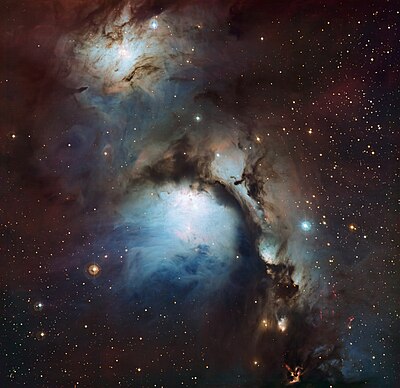
|
Messier 78 (M78) is a reflection nebula in the constellation Orion. It was discovered by French astronomer Pierre Méchain in 1780 and included by Charles Messier in his catalog of comet-like objects that same year. M78 is easily found with a small telescope as a hazy patch and features two stars of tenth and eleventh magnitude, which illuminate the cloud of dust in the nebula and make it visible. This photograph of the nebula was captured by the Wide Field Imager of the MPG/ESO telescope at the European Southern Observatory's La Silla Observatory in Chile. Photograph credit: Igor Chekalin
Recently featured:
|
January 15

|
Frances Benjamin Johnston (January 15, 1864 – May 16, 1952) was an early American photographer and photojournalist whose career lasted for almost half a century. She is most known for her portraits, images of Southern architecture, and various photographic series featuring African Americans and Native Americans at the turn of the 20th century. This 1896 photograph, entitled Self-Portrait (as "New Woman"), depicts Johnston seated in front of a fireplace, holding a cigarette in one hand and a beer stein in the other, in her studio in Washington, D.C. Photograph credit: Frances Benjamin Johnston; restored by Adam Cuerden
Recently featured:
|
January 16

|
|
Wrocław Cathedral, or the Cathedral of St. John the Baptist, is the seat of the Roman Catholic Archdiocese of Wrocław and a landmark of the city of Wrocław in Poland. The building, constructed in the Gothic and Neo-Gothic styles, is the fourth church to be built in the location between the 10th and 20th centuries. This photograph of the cathedral's interior shows the choir and sanctuary, looking towards the high altar. Photograph credit: Diego Delso
Recently featured:
|
January 17
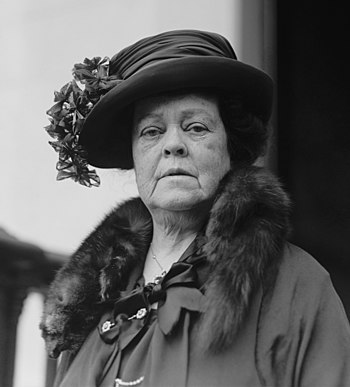
|
Alva Belmont (January 17, 1853 – January 26, 1933) was a prominent multi-millionaire American socialite and a major figure in the women's suffrage movement in the United States. She was noted for her energy, intelligence, strong opinions, and willingness to challenge convention. In 1909, she founded the Political Equality League to get votes for suffrage-supporting New York state politicians, wrote articles for newspapers, and joined the National American Woman Suffrage Association (NAWSA). In 1916, she was one of the founders of the National Woman's Party and organized the first picketing ever to take place before the White House in January 1917; she was elected president of the organization and held the office until her death. Photograph credit: Bain News Service; restored by Adam Cuerden
Recently featured:
|
January 18

|
The South Island oystercatcher (Haematopus finschi) is one of two common species of oystercatchers found in New Zealand. After breeding inland on the South Island, most of the population moves to estuaries, harbours, beaches and mudflats on the North Island, where the birds largely feed on molluscs and worms. It has piping calls, which are used socially and aggressively, as well as a piercing alarm call and a quiet flight call. This South Island oystercatcher was photographed in Point Chevalier in Auckland. Photograph credit: John Harrison
Recently featured:
|
January 19

|
Berlin Modernism Housing Estates is a World Heritage Site designated in 2008, comprising six subsidized-housing estates in Berlin, Germany. Dating mainly from the years of the Weimar Republic (1919–1933), when the city of Berlin was particularly progressive socially, politically and culturally, these buildings contributed to improving housing and living conditions for people with low incomes through innovative approaches to architecture and urban planning. This photograph is an aerial view of the Hufeisensiedlung (Horseshoe Estate), designed by the architect Bruno Taut and built in the late 1920s. Photograph credit: Alexander Savin
Recently featured:
|
January 20

|
Cecil Brown (1850–1917) was an American attorney, politician, businessman, and banker in the Kingdom, Republic, and Territory of Hawaii. He was the founding president of the first national bank chartered in Hawaii. This ten-dollar National Bank Note, issued in 1900, bears Brown's signature at the bottom right of the obverse. Banknote design credit: Office of the Comptroller of the Currency and the Bureau of Engraving and Printing; photographed by Andrew Shiva
Recently featured:
|
January 21

|
|
I puritani (The Puritans) is an 1835 opera by Vincenzo Bellini, set to an Italian libretto by Count Carlo Pepoli. This aquatint shows the set design for the Hall of Arms in act 1, scene 3, as it appeared at the opera's premiere at the Théâtre-Italien in Paris in January 1835. The opera was a great success; as Bellini reported to a friend: "The French had all gone mad; there were such noise and such shouts that they themselves were astonished at being so carried away." Aquatint credit: Luigi Verardi and Vittore Pedretti, after Domenico Ferri; restored by Adam Cuerden
Recently featured:
|
January 22

|
Charaxes jasius, the two-tailed pasha, is a species of butterfly in the family Nymphalidae. Occurring in maquis shrubland in southern Europe and northern Africa, the larva typically feeds on the leaves of the strawberry tree. It has a wingspan reaching 76 to 83 mm (3.0 to 3.3 in) in males, with females being slightly larger. This butterfly of the subspecies C. j. jasius was photographed in Sithonia, Greece. Photograph credit: Charles James Sharp
Recently featured:
|
January 23

|
Édouard Manet (23 January 1832 – 30 April 1883) was a French modernist painter. He was one of the first 19th-century artists to paint modern life, and was a pivotal figure in the transition from Realism to Impressionism. His early masterworks, Le Déjeuner sur l'herbe and Olympia, both painted in 1863, caused great controversy and served as rallying points for the young painters who would create Impressionism. Today, these are considered watershed paintings that mark the start of modern art. This portrait of Manet was taken by the French photographer Nadar. Photograph credit: Nadar; restored by Adam Cuerden
Recently featured:
|
January 24
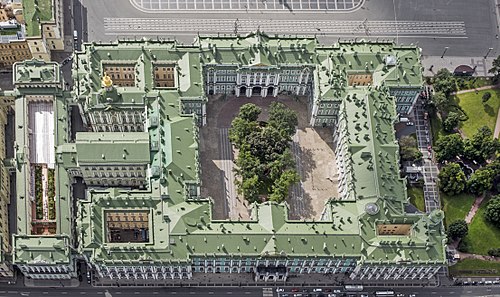
|
|
The Winter Palace is a palace in Saint Petersburg that served as the official residence of the Russian emperors from 1732 to 1917. The palace and its precincts now house the Hermitage Museum. The green-and-white palace has the overall shape of an elongated rectangle, with a 215-metre-long (705 ft) and 30-metre-high (98 ft) principal facade. The Winter Palace has been calculated to contain 1,886 doors, 1,945 windows, 1,500 rooms and 117 staircases. This aerial view of the palace was taken in 2016. Photograph credit: Andrew Shiva
Recently featured:
|
January 25

|
The Skating Minister is an oil painting attributed to Henry Raeburn in the Scottish National Gallery in Edinburgh. It was practically unknown until about 1949, but has since become one of Scotland's best-known paintings. It is considered an icon of Scottish culture, painted during one of the most remarkable periods in the country's history, the Scottish Enlightenment. The painting depicts Robert Walker, a Church of Scotland minister and a member of the Edinburgh Skating Club, the world's first organized figure skating club. The club often met at Duddingston Loch, the scene of this painting. Painting credit: Henry Raeburn (attributed)
Recently featured:
|
January 26

|
The Australian brushturkey (Alectura lathami), also known as the gweela, is a common, widespread species of mound-building bird in the family Megapodiidae (the incubator birds) found in eastern Australia. It is a large bird with a prominent, fan-like tail flattened sideways, and its plumage is mainly blackish, but with a bare red head, and a yellow or purple wattle. The male's wattle become much larger during breeding season, often swinging from side to side as it runs. The male's head and wattle also become much brighter during the breeding and nesting season. The brushturkey is a clumsy flyer and cannot fly long distances, only taking to the air when threatened by predators or to roost in trees at night and during the heat of the day. This Australian brushturkey was photographed in Newington, New South Wales. Photograph credit: John Harrison
Recently featured:
|
January 27

|
|
Lidar is a method for determining ranges by targeting an object with a laser and measuring the time taken by the reflected light to return to the receiver. Lidar can also be used to make digital 3-D representations of areas on the Earth's surface and ocean floor, due to differences in laser return times, and by varying laser wavelengths. It has terrestrial, airborne, and mobile applications. This image shows an orthographic projection of a registered point cloud depicting the intersection of Folsom Street and Dore Street in San Francisco, California. The point cloud was captured over 18 seconds and registered in real time using an Ouster OS1 lidar unit mounted on a moving car. The points are coloured by a function based on raw lidar intensity multiplied by range, with orange signifying brighter regions and dark blue for darker regions. Lidar is a popular sensor for self-driving cars. Image credit: Daniel L. Lu
Recently featured:
|
January 28

|
Ueno Tōshō-gū is a Shinto shrine located in the ward of Taitō in Tokyo, Japan. Tōshō-gū shrines are characterized by the enshrinement of Tokugawa Ieyasu under the name Tōshō Daigongen. This photograph shows Ueno Tōshō-gū's golden gate, which is a karamon, a type of mon in Japanese architecture characterized by the use of karahafu, a curved gable with a style peculiar to Japan. This karamon was built in 1651 and the Government of Japan has designated it an Important Cultural Property. Photograph credit: Basile Morin
Recently featured:
|
January 29

|
Albert Gallatin (January 29, 1761 – August 12, 1849) was a Genevan-American politician, diplomat, ethnologist and linguist. He is known for being the founder of New York University and for serving in the Democratic-Republican Party at various federal elective and appointed positions across four decades. He represented Pennsylvania in the Senate and the House of Representatives before becoming the longest-tenured United States secretary of the treasury (1801–1814) and serving as a high-ranking diplomat. This line engraving of Gallatin was produced around 1902 by the Department of the Treasury's Bureau of Engraving and Printing (BEP) as part of a BEP presentation album of the first 42 secretaries of the treasury. Engraving credit: Bureau of Engraving and Printing; restored by Andrew Shiva
Recently featured:
|
January 30

|
The swallow-tailed bee-eater (Merops hirundineus) is a near passerine bird in the bee-eater family, Meropidae, native to sub-Saharan Africa. About 20 centimetres (8 inches) in length, it feeds on insects, perching on a high branch and sallying forth to catch prey in mid-air. This swallow-tailed bee-eater of the subspecies M. h. chrysolaimus was photographed in Senegal. Photograph credit: Charles James Sharp
Recently featured:
|
January 31
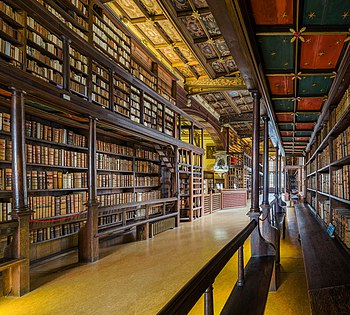
|
Duke Humfrey's Library is the oldest reading room in the Bodleian Library at the University of Oxford. It is named after Humphrey, Duke of Gloucester, a connoisseur of literature who donated his collection of 281 books to the university at his death in 1447. Books were hand-written at the time and his legacy was considered an extraordinarily generous donation, since the university previously had only 20 books. Duke Humfrey's Library was used as the library of Hogwarts for the filming of the Harry Potter films. Photograph credit: David Iliff
Recently featured:
|
Picture of the day archives and future dates
